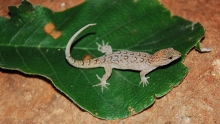The construction of a dam in central Brazil has spurred remarkably fast evolution of geckos in the region. In just 15 years, the lizards’ heads have grown larger—an adaptation that allows them to eat a wider assortment of insects made available by the dam’s creation. The find may portend other rapid evolutionary changes across the globe as humans continue to dramatically alter the natural landscape.
Starting in 1996, the dam flooded a series of valleys in Brazil’s savannalike Cerrado region, creating nearly 300 islands out of what was once high ground. Many of the area’s largest lizard species disappeared from the new islands, likely because there wasn’t enough food to support their energy needs. But a small, dragonfly-sized gecko called Gymnodactylus amarali—a termite eater once common across the flooded area—persisted on at least some of them. This created an opportunity: Larger termites, which had previously been eaten by the larger lizards, were now readily available to the geckos.
But there was a hitch. The geckos had small heads—only 1 centimeter wide—and some of the termites were nearly the same size. Eating them presented a challenge, kind of like a house cat trying to put a squirrel in its mouth.
To figure out whether the geckos were able to adapt, Mariana Eloy de Amorim, an evolutionary ecologist at the University of Brasília, and colleagues collected some animals on five of the islands in 2011 and compared them with geckos collected at five locations along the edge of the dam’s reservoir, habitat that was not isolated by flooding. They measured the size of the geckos and, after euthanizing them, cut open their stomachs to figure out what they had been eating.
 The results were startling: Despite the short time span, the island-bound geckos had heads that were 4% larger, the team reports today in the Proceedings of the National Academy of Sciences. That may seem like a small change, but with a larger mouth, the geckos were able to eat larger termites, giving them a more varied diet.
The results were startling: Despite the short time span, the island-bound geckos had heads that were 4% larger, the team reports today in the Proceedings of the National Academy of Sciences. That may seem like a small change, but with a larger mouth, the geckos were able to eat larger termites, giving them a more varied diet.
“You don’t get results like this every day,” says Thomas Schoener, an ecologist at the University of California, Davis, and a study author. “It’s kind of this eureka moment when you find a result that actually does back up your expectations about how something should work.”
But he adds that more work needs to be done to confirm that evolution was responsible for the change, and not phenotypic plasticity—the idea that an altered environment could trigger different growth trajectories, even if no genetic change has occurred. It’s “quite possibly some kind of plasticity, which I doubt, but it’s not ruled out by anything in the paper,” he says. “The next step will be to look at the underlying genetics of some of these changes.”
Even so, the “study nicely demonstrates how an environmental change can sometimes have multiple downstream effects on communities” writes Raymond Huey, an evolutionary biologist at the University of Washington in Seattle who was not involved in the study.
It’s also “exciting because it shows very rapid change on several islands, not just one,” says Daniel Simberloff, an ecologist at the University of Tennessee in Knoxville. A change on a single island could be a fluke, but the same change on a series of islands points to a bigger story—the adaptive advantage of having a big head. “It all fits, and that’s pretty impressive to see.”
As humans alter the fabric of landscapes, in Brazil and elsewhere, scenarios like this are becoming more and more common—with scientists rushing to figure out how organisms will respond. The “small lizards were able to adapt themselves to a new situation and forestall their own extinction,” Schoener says. But not all animals may be so lucky.
Fig. 1// The Gymnodactylus amarali gecko. Guilherme Santoro
Fig. 2// Researchers studied geckos on islands in Brazil’s Serra da Mesa reservoir. Anna Carolina Lins
Read the original article in Science Mag.

